Asana’s
Salutation to Âdinâtha (?iva) who expounded the knowledge of Ha?ha Yoga, which like a staircase leads the aspirant to the high pinnacled Râja Yoga.
Yogin Swâtmârâma, after saluting first his Gurû Srinâtha explains Ha?ha Yoga for the attainment of Raja Yoga.
Owing to the darkness arising from the multiplicity of opinions people are unable to know the Râja Yoga. Compassionate Swâtmârâma composes the Ha?ha Yoga Pradipikâ like a torch to dispel it.
Matsyendra, Gorak?a, etc., knew Ha?ha Vidyâ, and by their favour Yogî Swâtmârâma also learnt it from them.
The following Siddhas (masters) are said to have existed in former times:—
Sri Âdinâtha (?iva), Matsyendra, Nâtha, Sâbar, Anand, Bhairava, Chaurangi, Mîna nâtha, Gorak?anâtha, Virupâk?a, Bile?aya.
Manthâna, Bhairava, Siddhi Buddha, Kanthadi, Karantaka, Surânanda, Siddhipâda, Charapati.
Kânerî, Pûjyapâda, Nityanâtha, Nirañjana, Kapâli, Vindunâtha, Kâka Chandî?wara.
Allâma, Prabhudeva, Ghodâ, Cholî, Tinti?i, Bhânukî Nârdeva, Khanda Kâpâlika, etc.
These Mahâsiddhas (great masters), breaking the sceptre of death, are roaming in the universe.
Like a house protecting one from the heat of the sun, Ha?ha Yoga protects its practiser from the burning heat of the three Tâpas; and, similarly, it is the supporting tortoise, as it were, for those who are constantly devoted to the practice of Yoga.
A Yogî desirous of success should keep the knowledge of Ha?ha Yoga secret; for it becomes potent by concealing, and impotent by exposing.
The Yogî should practise Ha?ha Yoga in a small room, situated in a solitary place, being 4 cubits square, and free from stones, fire, water, disturbances of all kinds, and in a country where justice is properly administered, where good people live, and food can be obtained easily and plentifully.
The room should have a small door, be free from holes, hollows, neither too high nor too low, well plastered with cow-dung and free from dirt, filth and insects. On its outside there should be bowers, raised platform (chabootrâ), a well, and a compound. These characteristics of a room for Ha?ha Yogîs have been described by adepts in the practice of Ha?ha.
Having seated in such a room and free from all anxieties, he should practise Yoga, as instructed by his guru.
Yoga is destroyed by the following six causes:—Over-eating, exertion, talkativeness, adhering to rules, i.e., cold bath in the morning, eating at night, or eating fruits only, company of men, and unsteadiness.
The following six bring speedy success:—Courage, daring, perseverance, discriminative knowledge, faith, aloofness. from company.
The ten rules of conduct are: ahi?sâ (non-injuring), truth, non-stealing, continence, forgiveness, endurance, compassion, meekness, sparing diet and cleanliness.
The ten niyamas mentioned by those proficient in the knowledge of yoga are: Tapa, patience, belief in God, charity, adoration of God, hearing discourses on the principles of religion, shame, intellect, Tapa and Yajña.
Asanas
Being the first accessory of Hatha Yoga, asana is described first. It should be practised for gaining steady posture, health and lightness of body.
I am going to describe certain asanas which have been adopted by Munîs like Vasittha, etc., and Yogîs like Matsyendra, etc.
Swastikasana
Having kept both the hands under both the thighs, with the body straight, when one sits calmly in this posture, it is called Swastika.
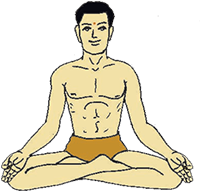
Gomukhasana
Placing the right ankle on the left side and the left ankle on the right side, makes Gomukha-âsana, having the appearance of a cow.
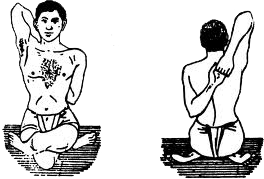
Virasana
One foot is to be placed on the thigh of the opposite side; and so also the other foot on the opposite thigh. This is called Vîrâsana.
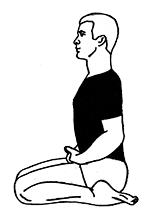
Kurmasana
Placing the right ankle on the left side of anus, and the left ankle on the right side of it, makes what the Yogîs call Kûrma-âsana.

Kukkutsana
Taking the posture of Padma-âsana and carrying the hands under the thighs, when the Yogî raises himself above the ground, with his palms resting on the ground, it becomes Kukku?a-âsana.
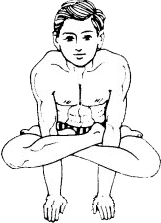
Uttana Kurmasana
Having assumed Kukku?a-âsana, when one grasps his neck by crossing his hands behind his head, and lies in this posture with his back touching the ground, it becomes Uttâna Kûrma-âsana, from its appearance like that of a tortoise.
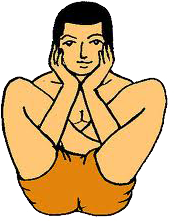
Dhanurasana
Having caught the toes of the feet with both the hands and carried them to the ears by drawing the body like a bow, it becomes Dhanura âsana.
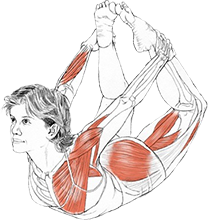
Matsyasana
Having placed the right foot at the root of the left thigh, let the toe be grasped with the right hand passing over the back, and having placed the left foot on the right thigh at its root, let it be grasped with the left hand passing behind the back. This is the âsana, as explained by ?ri Matsyanâtha. It increases appetite and is an instrument for destroying the group of the most deadly diseases. Its practice awakens the Kundalinî, stops the nectar shedding from the moon in people.

Patchimotasana
Having stretched the feet on the ground, like a stick, and having grasped the toes of both the feet with both the hands, when one sits with his forehead resting on the thighs, it is called Pa?chima Tâna.
This Pa?chima Tâna carries the air from the front to the back part of the body (i.e., to the su?umna). It kindles gastric fire, reduces obesity and cures all diseases of men.
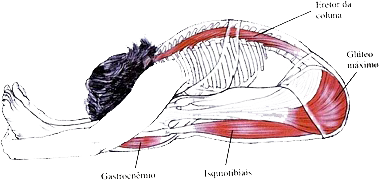
Mayurasana
Place the palms of both the hands on the ground, and place the navel on both the elbows and balancing thus, the body should be stretched backward like a stick. This is called Mayûra-âsana.
This Âsana soon destroys all diseases, and removes abdominal disorders, and also those arising from irregularities of phlegm, bile and wind, digests unwholesome food taken in excess, increases appetite and destroys the most deadly poison.
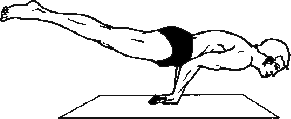
Savasana
Lying down on the ground, like a corpse, is called ?ava-âsana. It removes fatigue and gives rest to the mind.
?iva taught 84 âsanas. Of these the first four being essential ones, I am going to explain them here.
These four are:—The Siddha, Padma, Sinha and Bhadra. Even of these, the Siddha-âsana, being very comfortable, one should always practise it.
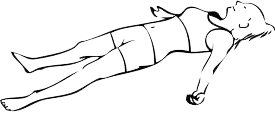
Siddhasana
Press firmly the heel of the left foot against the perineum, and the right heel above the male organ. With the chin pressing on the chest, one should sit calmly, having restrained the senses, and gaze steadily the space between the eyebrows. This is called the Siddha Âsana, the opener of the door of salvation.
This Siddhâsana is performed also by placing the left heel on Me?hra (above the male organ), and then placing the right one on it.
Some call this Siddhâsana, some Vajrâsana. Others call it Mukta Âsana or Gupta Âsana.
Just as sparing food is among Yamas, and Ahi?sâ among the Niyamas, so is Siddhâsana called by adepts the chief of all the âsanas.
Out of the 84 Âsanas Siddhâsana should always be practised, because it cleanses the impurities of 72,000 nâ?îs.
By contemplating on oneself, by eating sparingly, and by practising Siddhâsana for 12 years, the Yogî obtains success.
Other postures are of no use, when success has been achieved in Siddhâsana, and Prâ?a Vâyû becomes calm and restrained by Kevala Kumbhaka.
Success in one Siddhâsana alone becoming firmly established, one gets Unmanî at once, and the three bonds (Bandhas) are accomplished of themselves.
There is no Âsana like the Siddhâsana and no Kumbhaka like the Kevala. There is no mudrâ like the Khechari and no laya like the Nâda (Anâhata Nâda.)
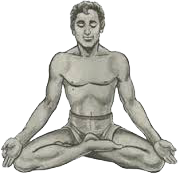
Padmasana
Place the right foot on the left thigh and the left foot on the right thigh, and grasp the toes with the hands crossed over the back. Press the chin against the chest and gaze on the tip of the nose. This is called the Padmâsana, the destroyer of the diseases of the Yamîs.
Place the feet on the thighs, with the soles upwards, and place the hands on the thighs, with the palms upwards.
Gaze on the tip of the nose, keeping the tongue pressed against the root of the teeth of the upper jaw, and the chin against the chest, and raise the air up slowly, i.e., pull the apâna-vâyû gently upwards.
This is called the Padmâsana, the destroyer of all diseases. It is difficult of attainment by everybody, but can be learnt by intelligent people in this world.
Having kept both the hands together in the lap, performing the Padmâsana firmly, keeping the chin Fixed to the chest and contemplating on Him in the mind, by drawing the apâna-vâyû up (performing Mûla Bandha) and pushing down the air after inhaling it, joining thus the prâ?a
and apâna in the navel, one gets the highest intelligence by awakening the ?akti (kundalinî) thus.
N?.—When Apâna Vâyû is drawn gently up and after filling in the lungs with the air from outside, the prâ?a is forced down by and by so as to join both of them in the navel, they both enter then the Kundalinî and, reaching the Brahma randhra (the great hole), they make the mind calm. Then the mind can contemplate on the nature of the âtmana and can enjoy the highest bliss.
The Yogî who, sitting with Padmâsana, can control breathing, there is no doubt, is free from bondage.
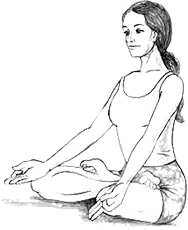
Simhasana
Press the heels on both sides of the seam of Perineum, in such a way that the left heel touches the right side and the right heel touches the left side of it.
Place the hands on the thighs, with stretched fingers, and keeping the mouth open and the mind collected, gaze on the tip of the nose.
This is Si?hâsana, held sacred by the best of Yogîs. This excellent Âsana effects the completion of the three Bandhas (The Mûlabandha, Kan?ha or Jâlandhar Bandha and U??iyâna Bandha).
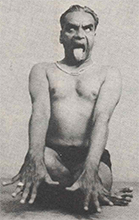
Bhadrasana
Place the heels on either side of the seam of the Perineum, keeping the left heel on the left side and the right one on the right side, hold the
feet firmly joined to one another with both the hands. This Bhadrâsana is the destroyer of all the diseases.
The expert Yogîs call this Gorak?a âsana. By sitting with this âsana, the Yogî gets rid of fatigue
The Nâdis should be cleansed of their impurities by performing the mudrâs, etc., (which are the practices relating to the air) Âsanas, Kumbhakas and various curious mûdrâs.
By regular and close attention to Nâda (anâhata nâda) in Ha?ha Yoga, a Brahmachari, sparing in diet, unattached to objects of enjoyment, and devoted to Yoga, gains success, no doubt, within a year.
Abstemious feeding is that in which ¾ of hunger is satisfied with food, well cooked with ghee and sweets, and eaten with the offering of it to ?iva.
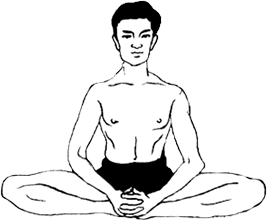
Foods injurious to a Yogî
Bitter, sour, saltish, hot, green vegetables, fermented, oily, mixed with til seed, rape seed, intoxicating liquors, fish, meat, curds, chhaasa pulses, plums, oil-cake, asafœtida (hînga), garlic, onion, etc., should not be eaten.
Food heated again, dry, having too much salt, sour, minor grains, and vegetables that cause burning sensation, should not be eaten, Fire, women, travelling, etc., should be avoided.
As said by Gorak?a, one should keep aloof from the society of the evil-minded, fire, women, travelling, early morning bath, fasting, and all kinds of bodily exertion.
Wheat, rice, barley, shâstik (a kind of rice), good corns, milk, ghee, sugar, butter, sugarcandy, honey, dried ginger, Parwal (a vegetable) the five vegetables, moong, pure water, these are very beneficial to those who practise Yoga.
A Yogî should eat tonics (things giving strength), well sweetened, greasy (made with ghee), milk, butter, etc., which may increase humors of the body, according to his desire.
Whether young, old or too old, sick or lean, one who discards laziness, gets success if he practises Yoga.
Success comes to him who is engaged in the practice. How can one get success without practice; for by merely reading books on Yoga, one can never get success.
Success cannot be attained by adopting a particular dress (Ve?a). It cannot be gained by telling tales. Practice alone is the means to success. This is true, there is no doubt.
Âsanas (postures), various Kumbhakas, and other divine means, all should be practised in the practice of Ha?ha Yoga, till the fruit—Râja Yoga—is obtained.
End of chapter 1st, on the method of forming the Âsanas.
